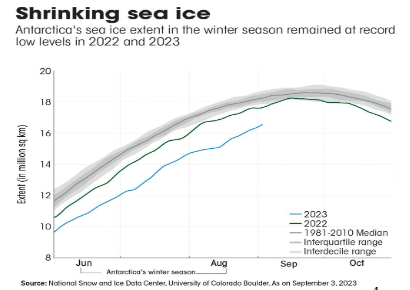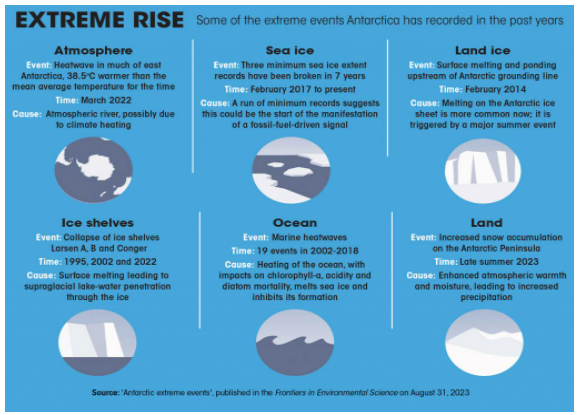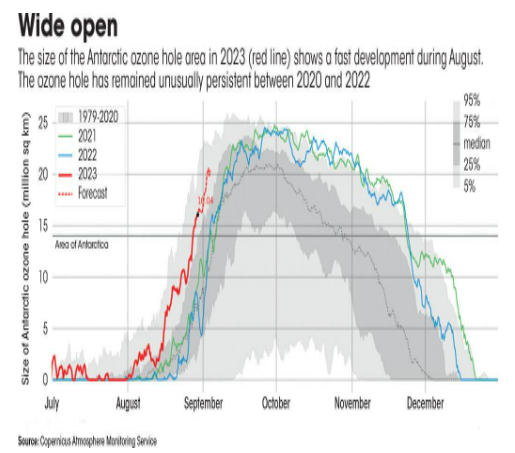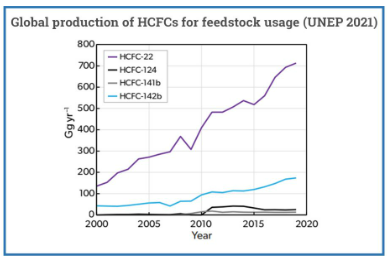Context:
- The 2023 winter season in Antarctica ended with a historic low in sea ice coverage, coinciding with the early emergence of the ozone hole over the continent.
More about the news:
About Antarctica:
- Antarctica is the vast frozen landmass located at the southernmost part of earth which plays a crucial role in influencing significant atmospheric and oceanic systems.
- It experiences the seasonal melting of its sea ice cover every summer, occurring between December and February, followed by a return to its original state during the winter months.
|
- Melting of Sea ice: Antarctica, whose temperature can go as low as -98°C, sees the melting of the sea ice cover every summer season between December and February before returning to its original state during the winters.
- Data from NASA Earth Observatory in the US revealed that the sea ice extent in July had reached lowest at approximately 13.5 million square kilometers since 1978.
- By August, an area of sea ice equivalent in size to Greenland had failed to regenerate.
- Five-sigma event: Scientists have described this as a five-sigma event, implying that, without climate changes, such a minimal sea ice cover would typically occur once in 7.5 million years.
- Changes in the polar vortex(PV) location: PV is a region of low pressure and cold air that encircles both Earth’s poles.
- It has shifted to allow for a greater southward flow over the Antarctic sea ice. As a result, more sea ice is being pushed towards the southern reaches of the continent.
- PV speeds up the mechanism by which the Ozone Depleting Substances (ODS)present in the stratosphere destroy ozone.

Shrinking sea ice:
- Antarctic sea ice is marked by reduced overall sea ice extent and shorter durations of sea ice presence reflecting impact of climate change and anthropogenic greenhouse gas emissions.
- As reported by NASA Earth Observatory, record-low extents in Antarctica sea ice was observed in 2017, 2022, and now in 2023.

Challenges with melting of sea ice:
- Rise in extreme events: Increasing temperatures is leading to a recurring series of extreme events impacting its atmosphere, ocean, cryosphere, and biosphere.
- Heatwave: In March 2022, east Antarctica experienced an unprecedented heatwave with temperature reaching 38.5°C and subsequent melting event.
- This extreme heat event was linked to an atmospheric river that transported warm and moisture-laden air from Australia deep into the heart of the continent.
- In February 2020, Antarctica’s mainland recorded its highest temperature of 18.3°C at the Esperanza station.
- Cyclonic events: These were witnessed on account of calving of an iceberg on the Brunt Ice Shelf.
Reasons behind extreme events:
- High-Pressure(HP)systems: As outlined in a research paper published in the Frontiers in Environmental Science on August 8, 2023, HP systems are identified as contributors to these extreme weather events in Antarctica besides atmospheric rivers and cyclones.
- Marine heatwaves: These are regions of the ocean experiencing prolonged periods of above-normal sea surface temperatures.
- Potential intrusion of warm mid-depth water: Referred to as circumpolar deep water, their penetration into Antarctica’s ice shelves and glaciers, poses threat to their stability.
- Since 2009, major icebergs have broken off from ten ice shelves across the continent, and this process is exacerbated by changing atmospheric conditions, including strong winds.
- Disruption in ice flow: The removal of ice shelves and other extreme internal events also disrupts the flow of ice on Antarctica’s land surface.
- An example of this occurred in the Siple Coast ice stream in West Antarctica.
- Ice flow is further influenced by factors such as meltwater formation due to atmospheric rivers, strong winds, rainfall, and cloud cover
|
- Impact on marine ecosystem:
Meridional overturning circulation:
- The meridional overturning circulation is an essential underwater process whereby warm equatorial ocean water travels to the North Atlantic, while cold water flows back towards the Equator and then towards Antarctica.
- It completes this cycle by returning to the tropics and warming again.
- This circulation not only spreads warmth to different parts of the world but also transports vital nutrients necessary to support marine life.
|
-
- Absorption capacity of oceans: The reduction in sea ice leads to greater absorption of the sun’s energy by the oceans, accelerating the melting of sea ice, creating a self-reinforcing feedback loop.
- Impact on Antarctic bottom water: It plays a vital role in regulating the ocean’s capacity to store heat and capture carbon.
- Reduced production of Antarctic bottom water: It results in reduced production of Antarctic bottom water, a critical component of the meridional overturning circulation.
- As per the study published in the journal Nature Climate Change, the bottom waters in the Weddell Sea in Antarctica have shrunk by 20 per cent over the past 30 years, while shallower waters warmed at a rate five times higher than the rest of the global ocean.
- Impact on atmospheric determinants:
- Gaseous exchange: Disruption of the sea ice melt and growth cycle impacts the exchange of gasses and other materials between the ocean and atmosphere.
- For instance, ocean water absorbs more carbon dioxide than sea ice, which stores the compound in the form of a salty brine solution.
- Impact on cloud formation: Aerosol production gets affected by the low sea ice cover, leading to less cloud cover over the Southern Ocean.
- This leads to more striking of the sun’s energy to the Earth and further warming.
- Impact on Antarctic biosphere:
- Impact on local ecology: As per a research paper published in Nature Communications Earth and Environment, out of five emperor penguin colonies studied in Antarctica, four showed complete failure of breeding in the season.
- Between 2018 and 2022, approximately 42 percent of emperor penguin colonies experienced total or partial breeding failure due to fast ice breakup in at least one year.
- Impact on primary producers: Krill, zooplankton and phytoplankton get affected by low sea ice extent having a knock-on effect on other organisms dependent on them.
- The Antarctic ozone hole represents an annual thinning of the ozone layer in the stratosphere.
- It contains a high concentration of ozone molecules responsible for absorbing harmful ultraviolet radiation from the sun.
|
Expansion of Ozone hole in Antarctica: The ozone hole formation over Antarctica starts at the end of September, reaches its peak size in October, and then gradually closes in November or December.
- However, this year, the ozone hole began forming in August, raising concerns about the potential for a larger-than-average hole.

- On September 1, the ozone hole over Antarctica measured 19.67 million square kilometers, as reported on NASA’s ozone hole webpage.
Reason behind early eruption of Antarctic ozone hole:
- Volcanic eruption: It can be attributed to the eruption of the Hunga-Tonga volcano in January 2022.
- The volcanic eruption released water vapor estimated at around 50 million tonnes into the stratosphere which eventually reached the Antarctic stratosphere.
- Polar stratospheric clouds(PSC): The increased water vapor in the stratosphere promoted the formation of PSC where chlorofluorocarbons can react and accelerate ozone depletion.
- The presence of water vapor contributes to cooling the Antarctic stratosphere, enhancing the formation of these PSCs resulting in a stronger polar vortex.
- Polar stratospheric clouds (PSCs) form during winter months in the Polar Stratosphere region at altitudes ranging from 15000-25000 meters.
- PSC primarily comprises supercooled water droplets and Nitric Acid, which implies its role in Ozone Hole formation.
|
Success of Montreal Protocol in recovery of ozone hole:
The Montreal Protocol
- Adopted on 16 September 1987, it regulates the production and consumption of man-made chemicals referred to as ozone depleting substances (ODS).
- The Protocol is to date one of the rare treaties to achieve universal ratification.
- Hydrochlorofluorocarbons (HCFCs) are being phased out under the Montreal Protocol since they deplete the ozone layer.
Kigali Amendment-Phase down of HFCs :
- The Parties to the Montreal Protocol reached an agreement at their 28th Meeting of the Parties on 15 October 2016 in Kigali, Rwanda to phase down hydrofluorocarbons(HFCs).
- Countries agreed to add HFCs to the list of controlled substances and approved a timeline for their gradual reduction by 80-85 per cent by the late 2040s
|
- Recovery of ozone hole: It has been gradually recovering since the 1987 Montreal Protocol led to the phasing out of ODS like chlorofluorocarbons.
- In October 2022, the World Meteorological Organization predicted that the entire world, except for the poles, would recover from the ozone hole by 2040.
- Full recovery at the poles is expected by 2066.
- Despite the ongoing recovery, the past three years have seen the presence of robust and enduring Antarctic stratospheric polar vortices, with ozone holes that have been among the largest and most persistent on record.
Way Forward:

- Reducing emissions from feedstocks: Feedstocks refers to substances that undergo a chemical transformation during the process of making other chemicals.
- The production, use and disposal of feedstocks results in harmful emissions, but ODS and HFC production for feedstock use is exempt from Montreal Protocol controls.
- It is therefore imperative that Parties agree measures to reduce industrial emissions from the production and use of feedstocks.
- Global framework for destroying ODS and HFCs banks: The stores of ODS and HFCs contained in existing equipment (fridges, air-conditioning units, etc) are known as banks.
- Currently, banks are releasing about 150 million tonnes of CO2-equivalent emissions every year.
- Emissions from banks of ozone-destroying CFCs alone could potentially delay Antarctic ozone hole recovery by about six years.
- Strengthening MRV+E: Monitoring, reporting, verification and enforcement (MRV+E) are at the core of Montreal Protocol’s success.
- CFC-11 is being illegally produced and used in eastern China (potentially delaying polar ozone recovery by up to three years).
- Curbing N2O emissions:In the past four decades, anthropogenic (human-caused) N2O emissions have increased by 30 per cent. These undermine both the recovery of the ozone layer, and global efforts to limit warming.
- Attaining paris agreement goals: Achieving the 1.5-degree Celsius target outlined in the Paris climate agreement would lead to a reduction in melting of Antarctic ice.
- Global agreement: The effectiveness of the Montreal Protocol provides a lesson for establishing a worldwide treaty framework for addressing concerns related to climate change.
News Source: DTE
![]() 18 Sep 2023
18 Sep 2023



